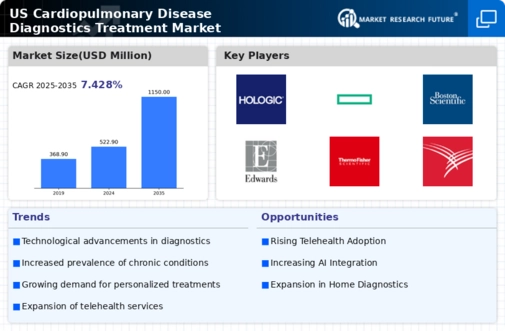Rising Healthcare Expenditure
The increasing healthcare expenditure in the US is a significant driver for the cardiopulmonary disease-diagnostics-treatment market. As healthcare spending continues to rise, there is a greater allocation of resources towards advanced diagnostics and treatment options for cardiopulmonary diseases. According to the National Health Expenditure Accounts, healthcare spending is projected to reach approximately $6 trillion by 2027, indicating a robust investment in healthcare services. This financial commitment allows for the integration of innovative technologies and therapies, enhancing the capabilities of healthcare providers in managing cardiopulmonary conditions. Consequently, the cardiopulmonary disease-diagnostics-treatment market is likely to benefit from this upward trend in healthcare investment.
Increased Awareness and Education
There is a growing awareness and education regarding cardiopulmonary diseases among the US population, which serves as a crucial driver for the cardiopulmonary disease-diagnostics-treatment market. Public health campaigns and educational initiatives have significantly improved understanding of risk factors, symptoms, and the importance of early diagnosis. This heightened awareness encourages individuals to seek medical attention sooner, leading to increased demand for diagnostic services and treatment options. As patients become more informed, healthcare providers are prompted to enhance their offerings in the cardiopulmonary disease-diagnostics-treatment market, ensuring that they meet the evolving needs of their patient populations.
Advancements in Medical Technology
The rapid advancements in medical technology are transforming the market. Innovations such as artificial intelligence, machine learning, and telehealth solutions are enhancing diagnostic accuracy and treatment efficacy. These technologies enable healthcare providers to deliver personalized care and improve patient outcomes. For instance, AI-driven diagnostic tools can analyze medical data more efficiently, leading to quicker and more accurate diagnoses. As these technologies become more integrated into clinical practice, the cardiopulmonary disease-diagnostics-treatment market is expected to expand, driven by the demand for more effective and efficient healthcare solutions.
Regulatory Support for Innovative Treatments
Regulatory bodies in the US are increasingly supporting the development and approval of innovative treatments for cardiopulmonary diseases. The Food and Drug Administration (FDA) has streamlined processes for the approval of new diagnostic tools and therapies, which encourages companies to invest in research and development. This regulatory environment fosters innovation, allowing for the introduction of cutting-edge technologies in the cardiopulmonary disease-diagnostics-treatment market. As a result, healthcare providers gain access to more effective solutions, which can lead to improved patient outcomes. The potential for expedited approvals and incentives for breakthrough therapies may significantly enhance market growth, as stakeholders recognize the value of timely access to advanced treatment options.
Growing Prevalence of Cardiopulmonary Diseases
The increasing incidence of cardiopulmonary diseases in the US is a primary driver for the market. According to the Centers for Disease Control and Prevention (CDC), heart disease and chronic respiratory conditions affect millions of Americans, leading to heightened demand for effective diagnostic and treatment solutions. This trend is further exacerbated by an aging population, as older adults are more susceptible to these conditions. The market is projected to grow as healthcare providers seek advanced diagnostic tools and treatment options to manage these diseases effectively. The financial implications are substantial. Healthcare costs associated with cardiopulmonary diseases reach billions of dollars annually, driving investments in innovative diagnostics and treatment methodologies.




















Leave a Comment